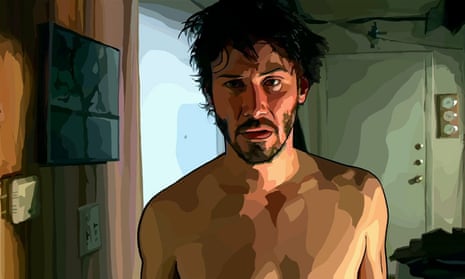"Darkly" is right. Everything about the new movie from Richard Linklater is murky, gloomy and mysterious. A druggie nightmare unfolds, and watching it is a bit like drinking the proverbial bong water. It is intriguing and weirdly gripping too, though. The longueurs resemble a stoner's ramblings, but they have a structural purpose, leading the film meandering and gibbering and zombie-walking up to its very disturbing finale, whose ultimate revelation wouldn't be quite so chilling without the twilit bewilderment that came before.
A Scanner Darkly is a computer-animated adaptation of Philip K Dick's 1977 sci-fi novel set in a near-future, when the US is obsessed with the war on drugs, particularly a hyper-addictive substance called D (for Death). This is the pretext for enforcing a police state using numberless surveillance scanners: hence the title, a twist on Corinthians, "we see as through a glass darkly" - though there is no great kinship with the Bergman film of that name. It is animated by Bob Sabiston, using his unique and instantly identifiable digital-rotoscope technique, in which live action is re-created as a throbbing virtual reality. It was used on Linklater's hallucinatory fantasy Waking Life and in one section of The Five Obstructions by Lars von Trier and Jorgen Leth, but the effects here are much more subdued: less freaky, less spacey - in keeping with the downbeat mood.
Keanu Reeves plays Bob Arctor, a narc on the verge of a crack-up. For public appearances as a cop, he has to wear a special hi-tech disguise to protect his identity, including a strange mask which shows his face as a shifting kaleidoscope of features. It is wearing this bizarre outfit that he first appears, addressing an anti-drugs conference sponsored by the New Path pharmaceutical corporation, which has an exclusive, lucrative contract with the government to supply detox and rehab services. As with all corporations in the movies, there is something very dodgy about it. This opening scene is, in fact, where Sabiston's animation is at its most disturbing and dreamlike, as the array of suit-clad execs sit with their nodding-dog heads, bland and smiley, like the projection of some narcotically induced nightmare.
Arctor's impending breakdown is accelerated by the burden of spying on a group of sad-sack addicts, and he is under such deep cover that these losers and fantasists are now his only friends: the hyperactive and duplicitous Barris (Robert Downey Jr), dopey slacker Ernie (Woody Harrelson), unhappy Freck (Rory Cochrane) and the beautiful cokehead Donna (Winona Ryder), with whom, in his listless way, Arctor is in love. Linklater has an amusing scene in which these idiots have a pointless, jabbering argument about a bicycle that one of them has bought: a rare occasion on which they are talking about something other than drugs. Things get very strange and scary when, in the line of duty, Arctor must enslave himself to the pitiless Death substance, and when a senior drug agent, whose only contact with Arctor is when he is wearing this prophylactic disguise-suit, and who is furthermore unaware of his civilian identity, in effect orders him to spy on himself. But why? Arctor's contacts are small-time and hopeless: why is he being pushed so relentlessly into this horrific situation?
A Scanner Darkly is a very dour film, labouring under a lowering sky of paranoia and repressed discontent. It has the feel of the apocalypse about it, a sense of these being the last days. There is one moment that is very similar to Waking Life, with its babbling street-corner preachers and jeremiahs: a former intelligence cop, berating the public through a megaphone about the destruction of civil liberties, is bundled into a sinister unmarked van. He was never heard of before, and he is never heard of again.
Reeves's own performance is typically opaque, and occluded and alienated further by the animation. At the nadir of his despair and double-agent confusion, he wonders whether the agencies spying on him through their scanners have a clearer idea of who he is than he has himself. He has surrendered himself so totally to the service of the state that the authorities now have a godlike insight into him: godlike in its power, that is, but with a very human malice and caprice.
The movie is often startling and engrossing, but the question of what the heck is going on, and why, is never entirely absent from your mind. And unlike the conspiracy nightmares of John Frankenheimer, Linklater's movie certainly does not feel under great compunction to offer a crisp explanation.
The question of surveillance became a hot-button topic in the cinema with the release of Michael Haneke's masterpiece Hidden last year, which also toys with the idea of CCTV and video surveillance being a kind of postmodern, amoral recording angel. However, Haneke's vision is clearer and more pertinent than this movie, which does not have its razor-edge clarity and pitiless chill, preferring to offer a stifling fug of bafflement and fear. It is distinctive work, and in its unwholesome and claustrophobic way, it lingers unsettlingly in the mind.
